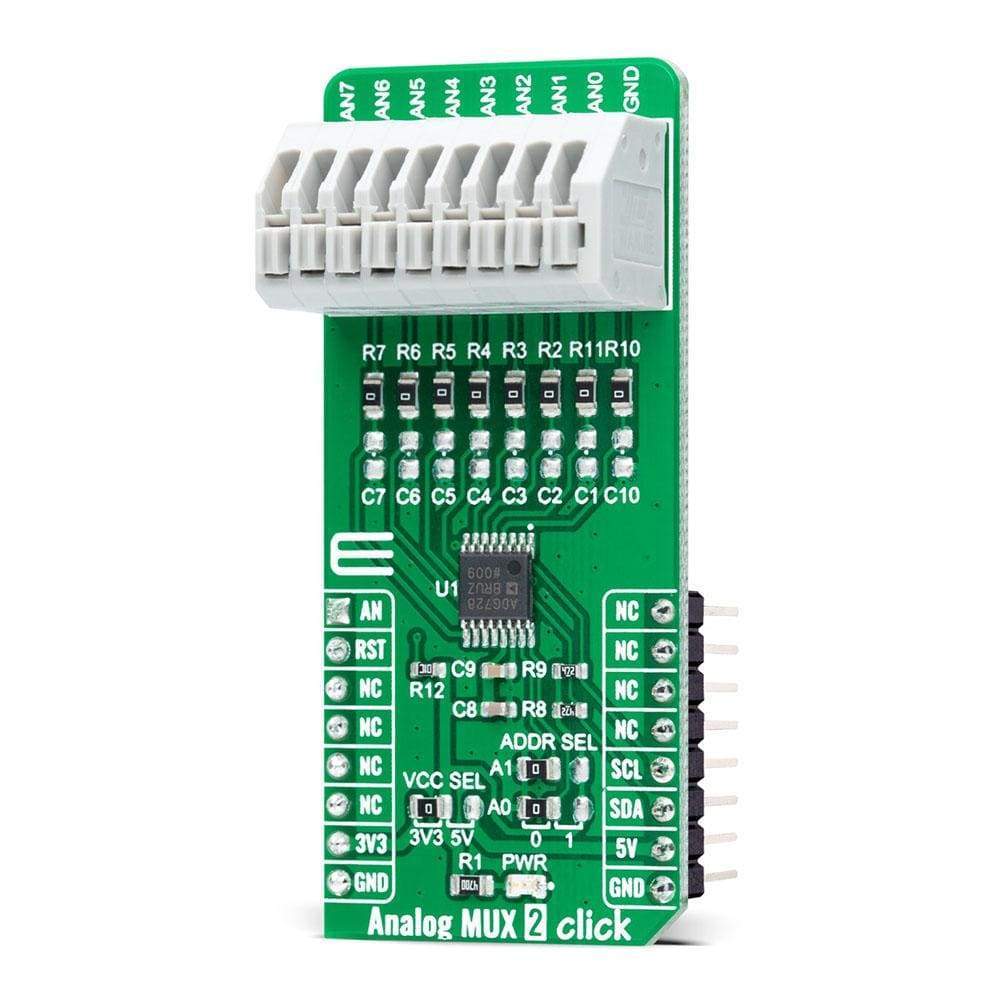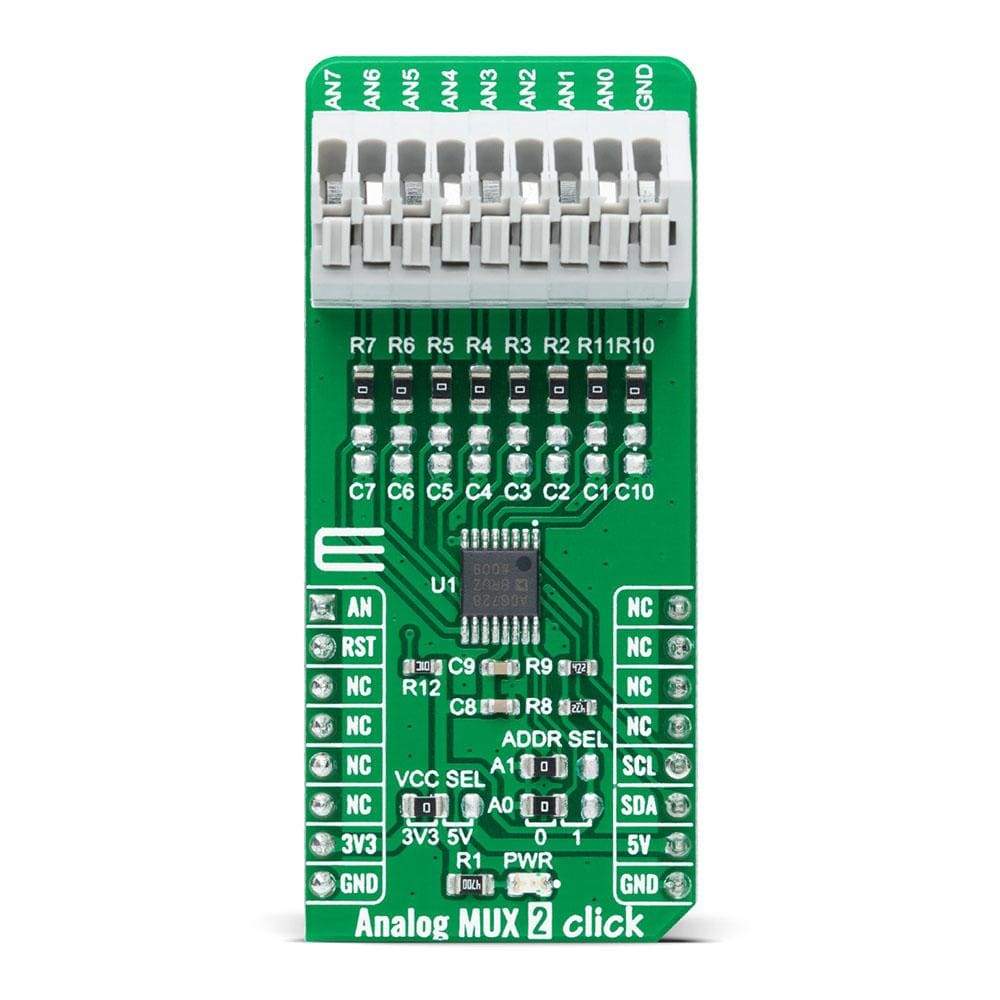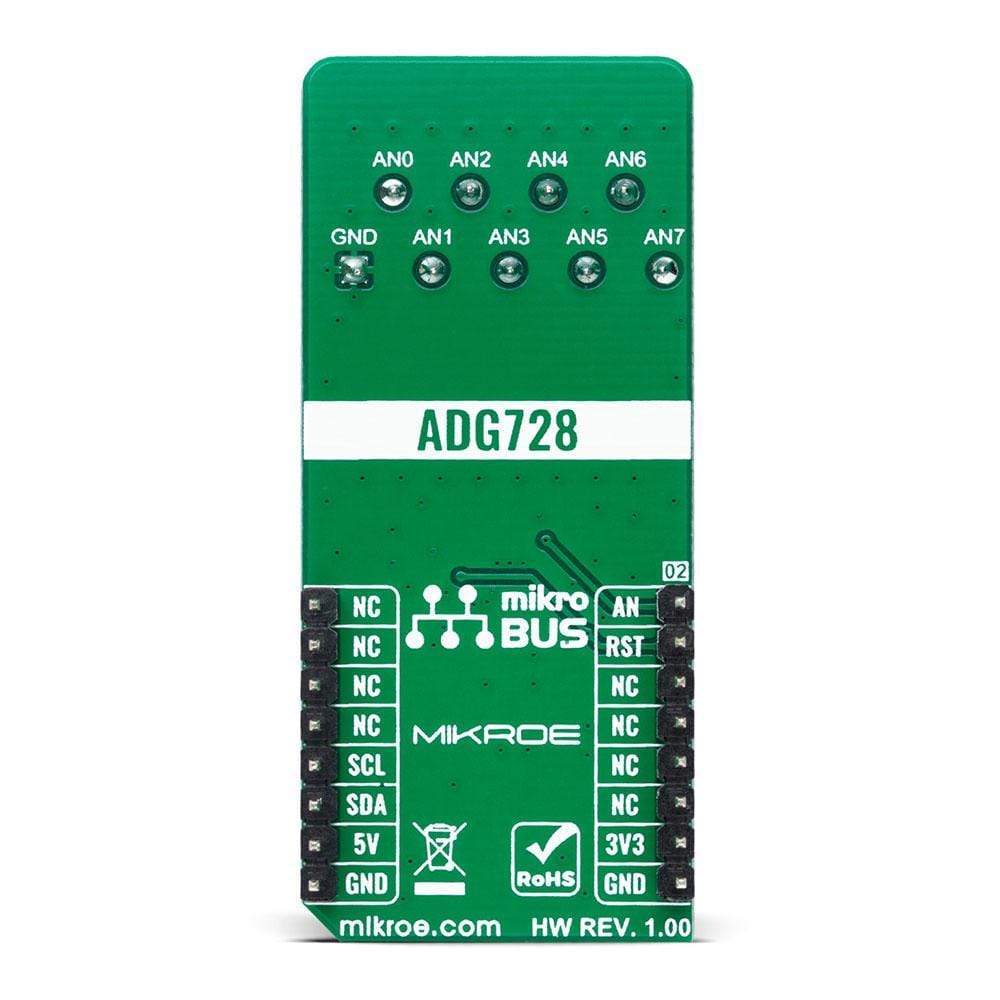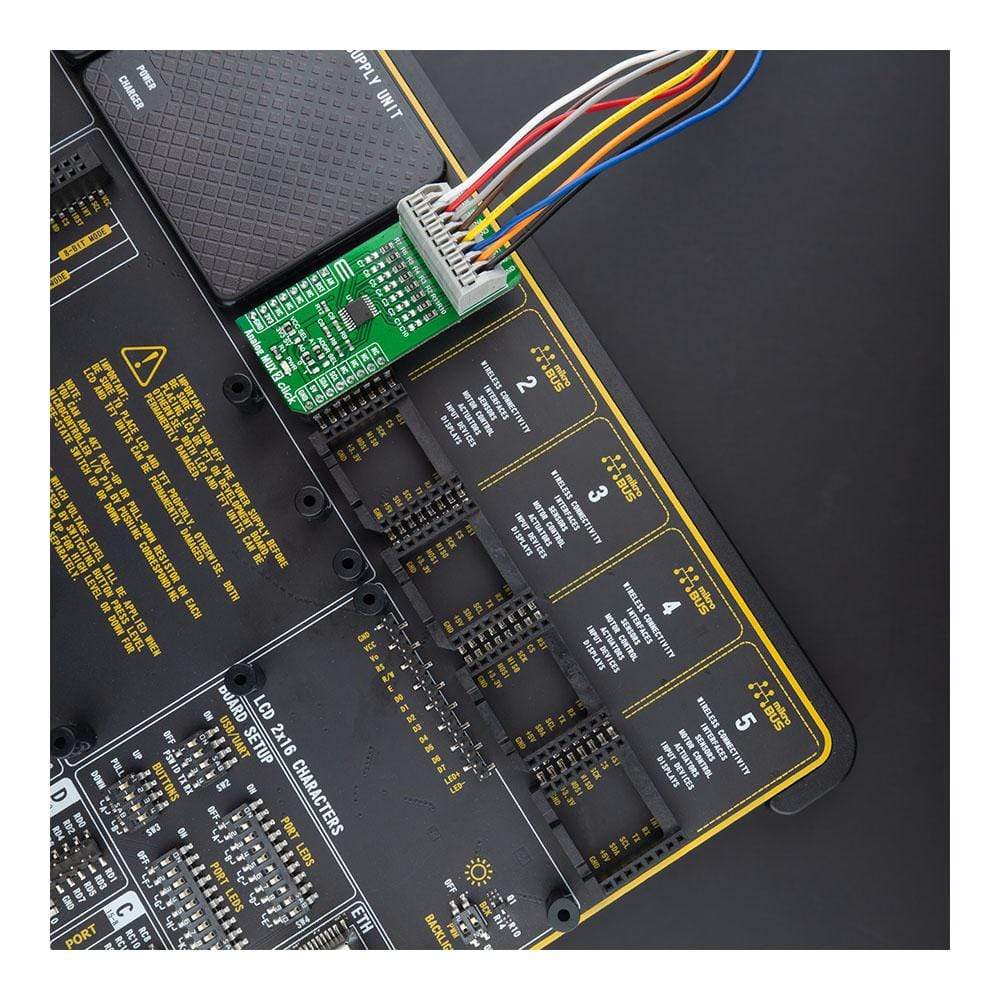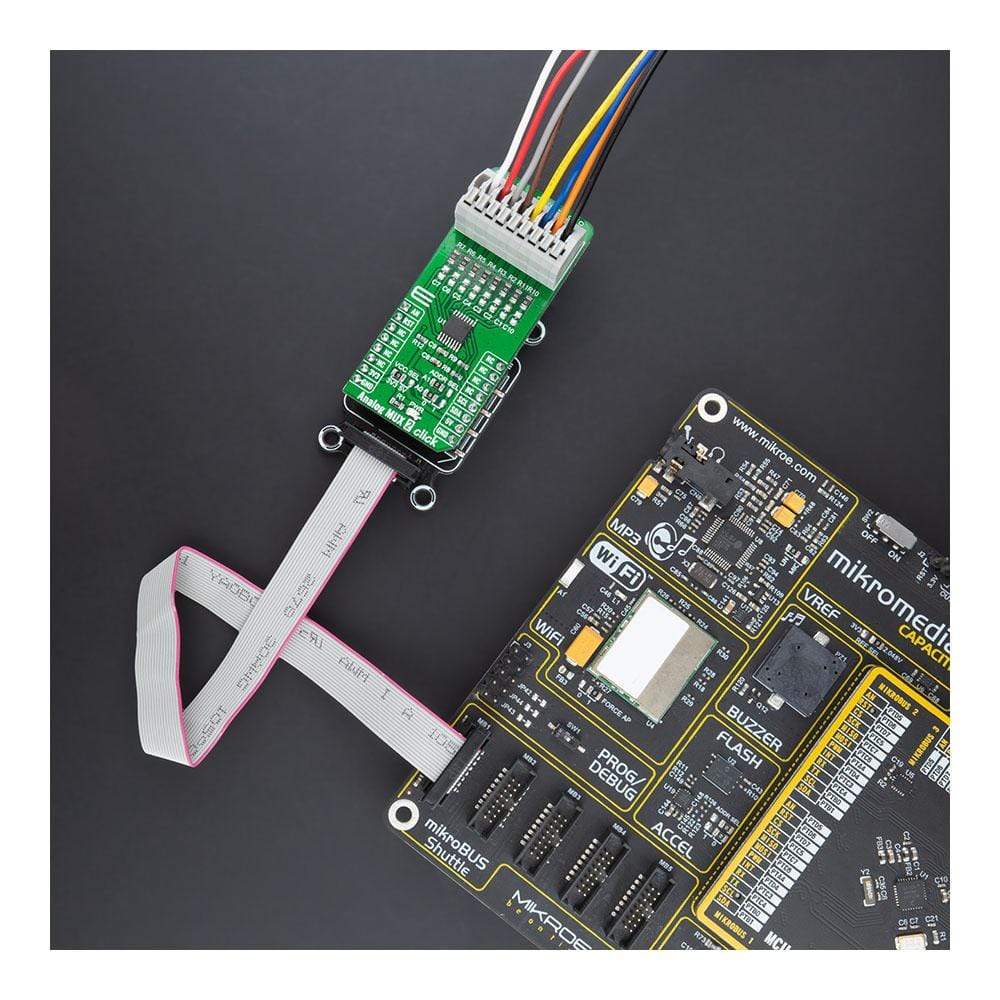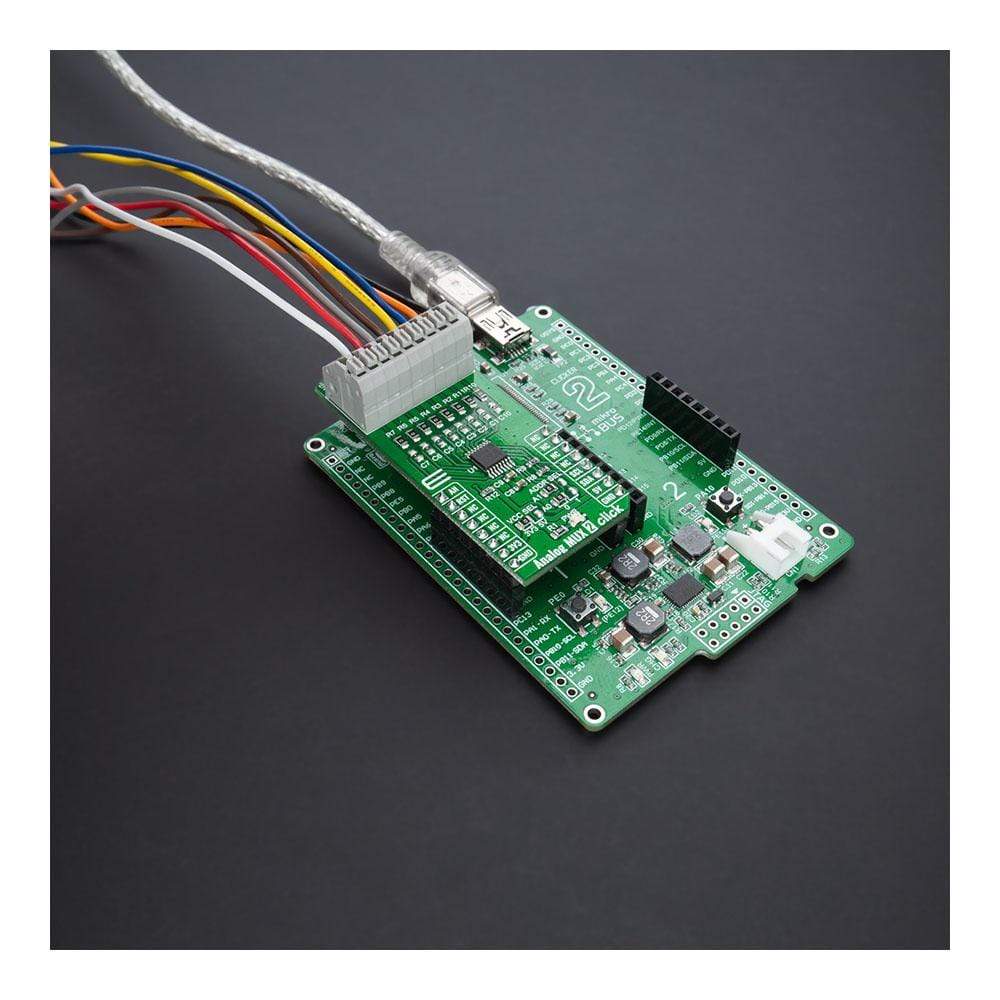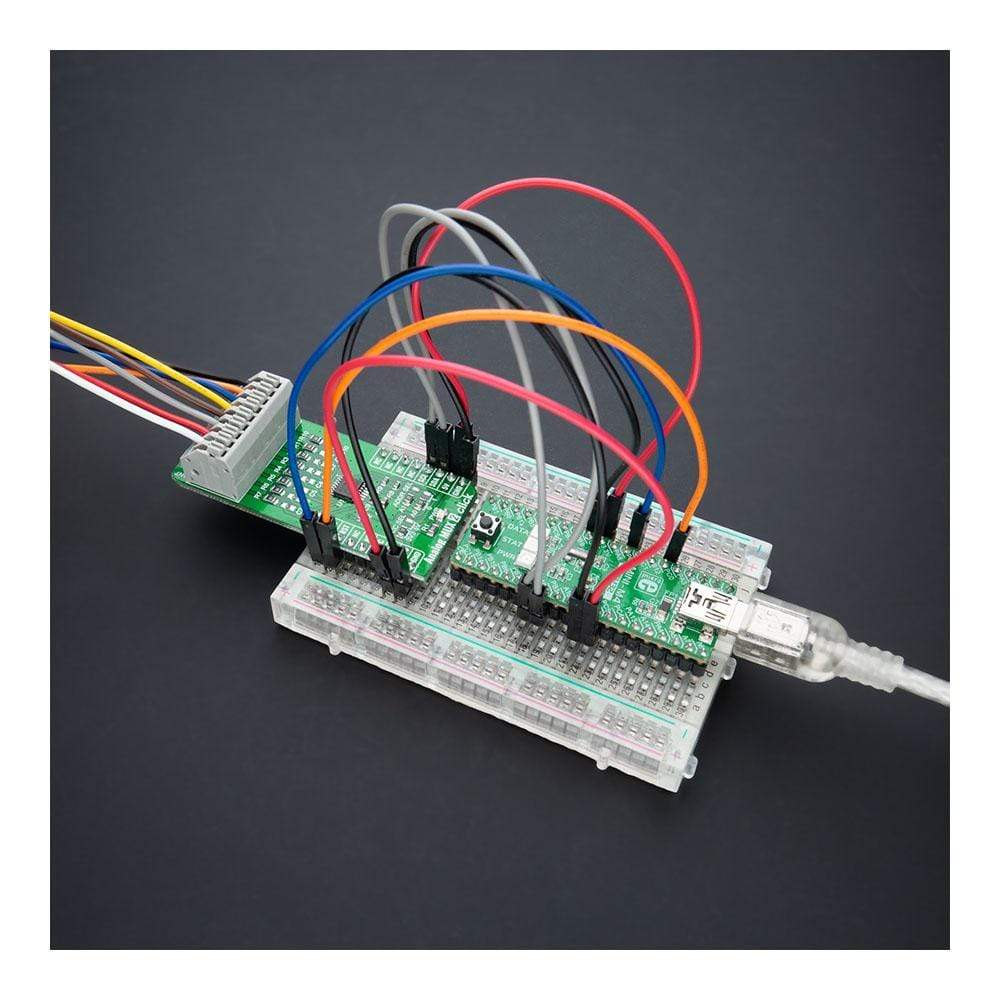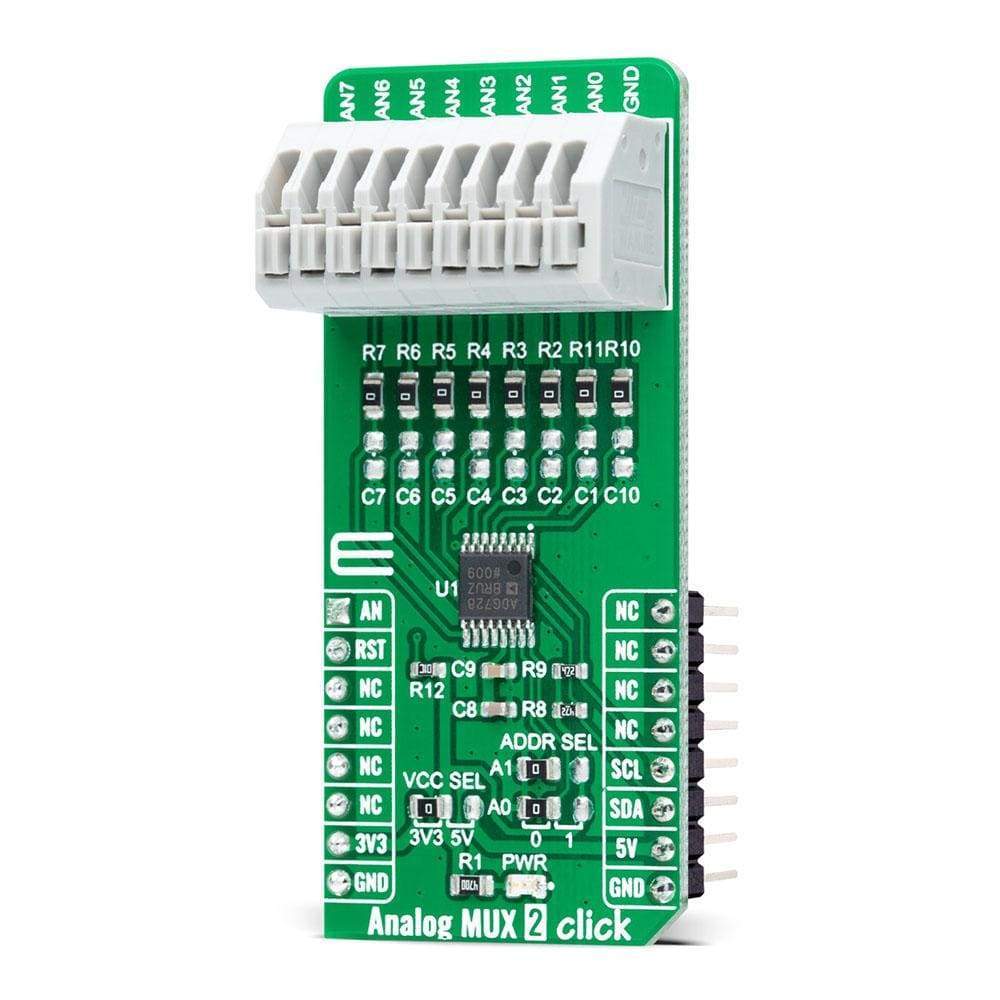
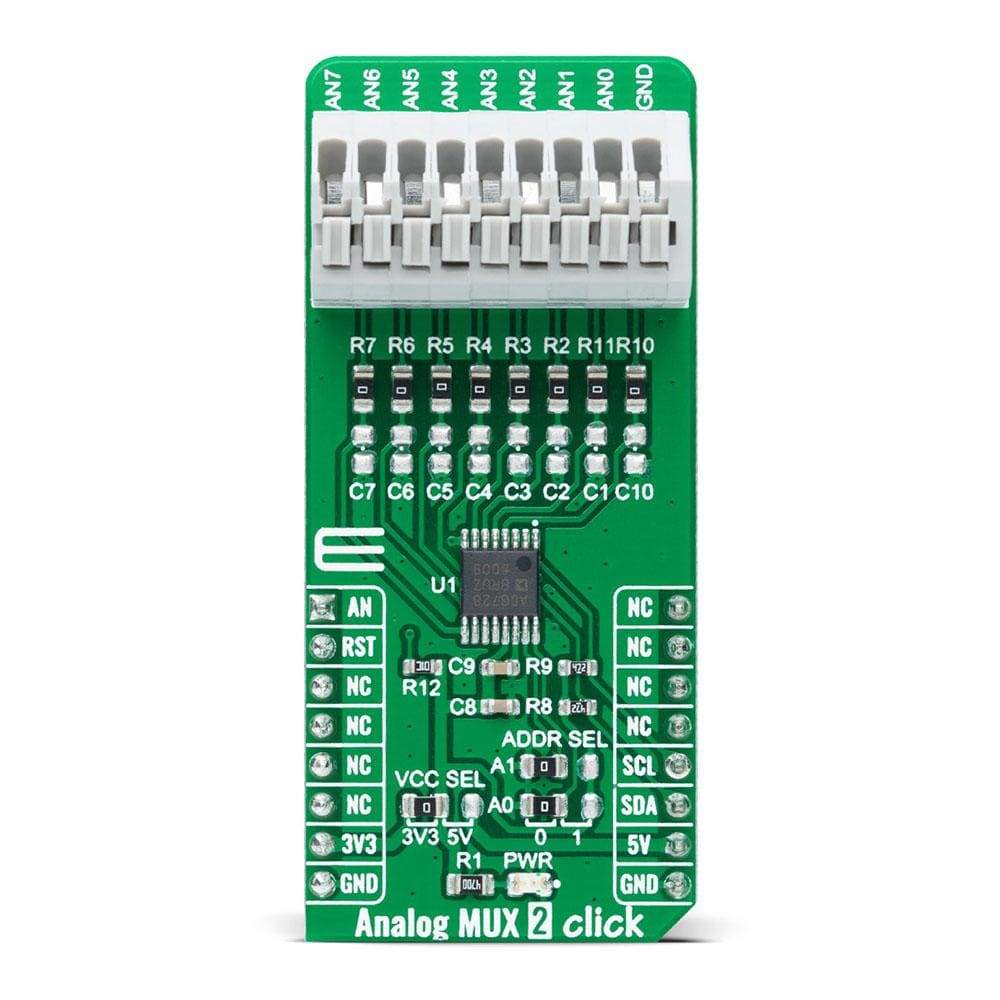
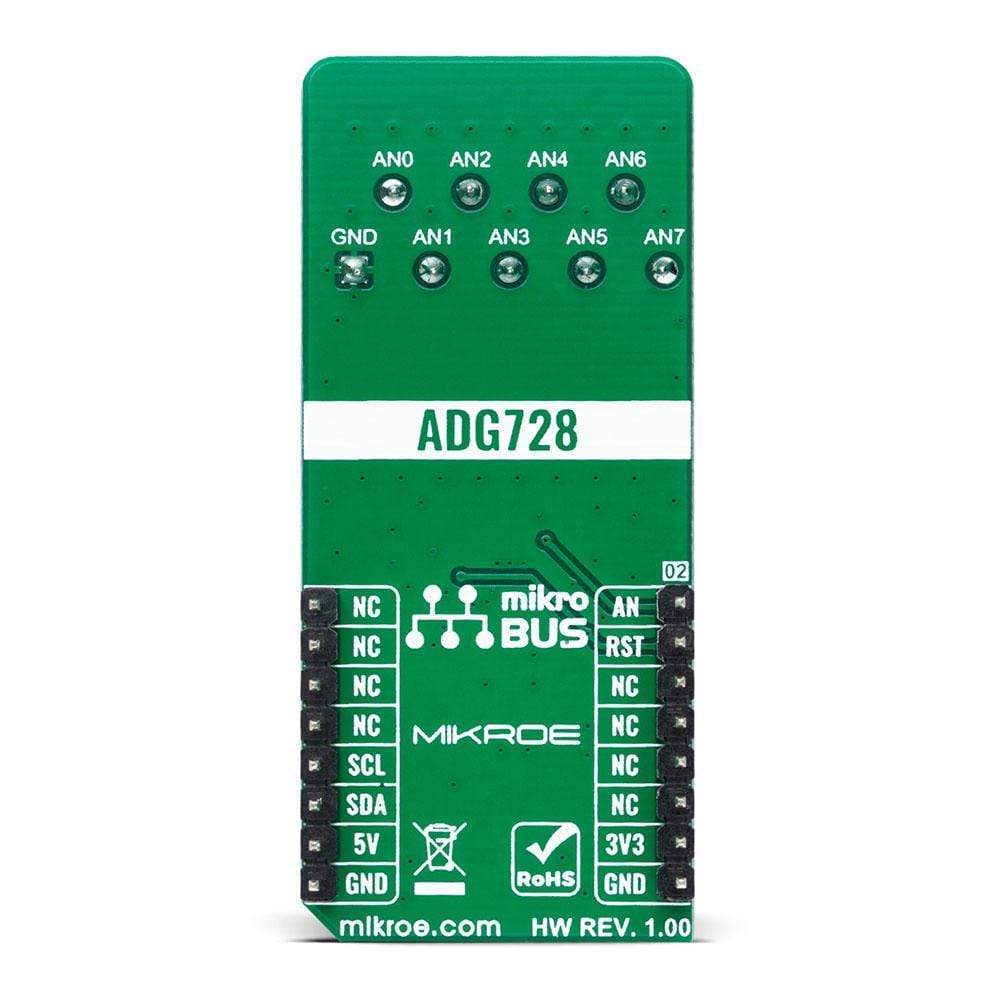
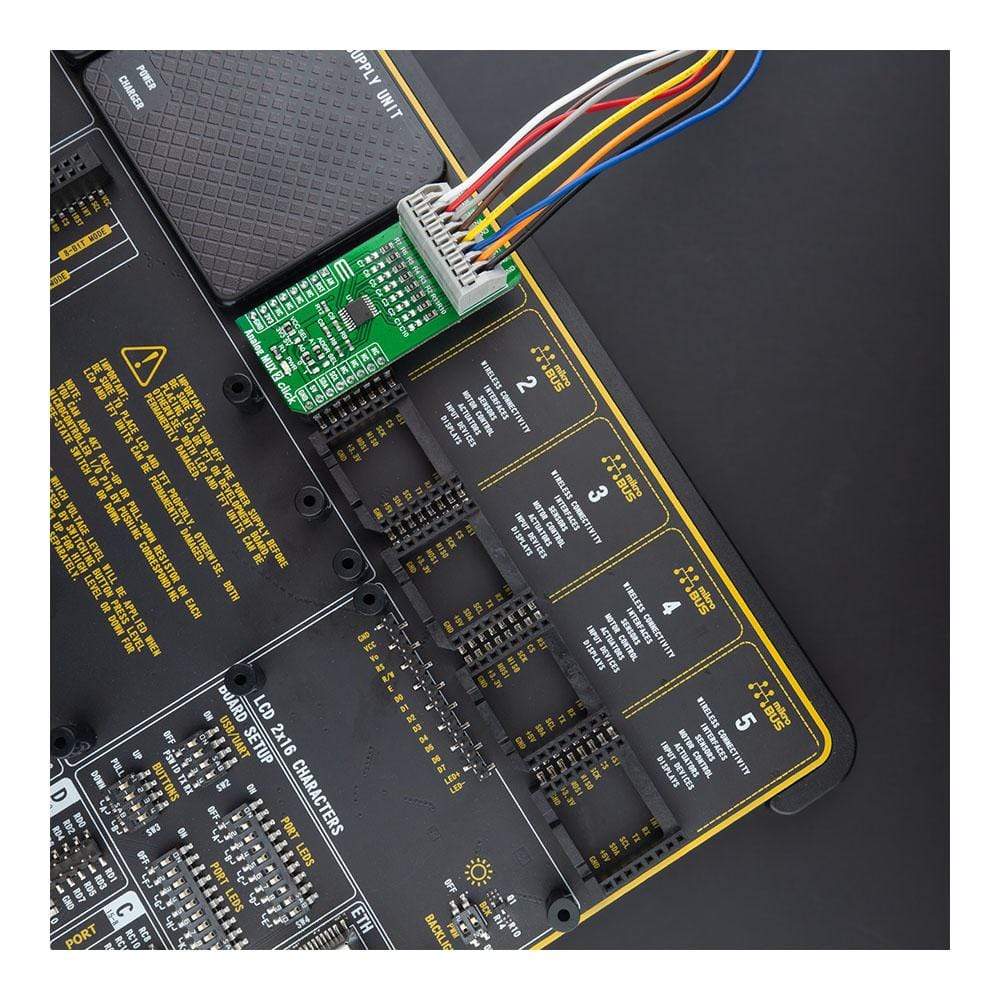
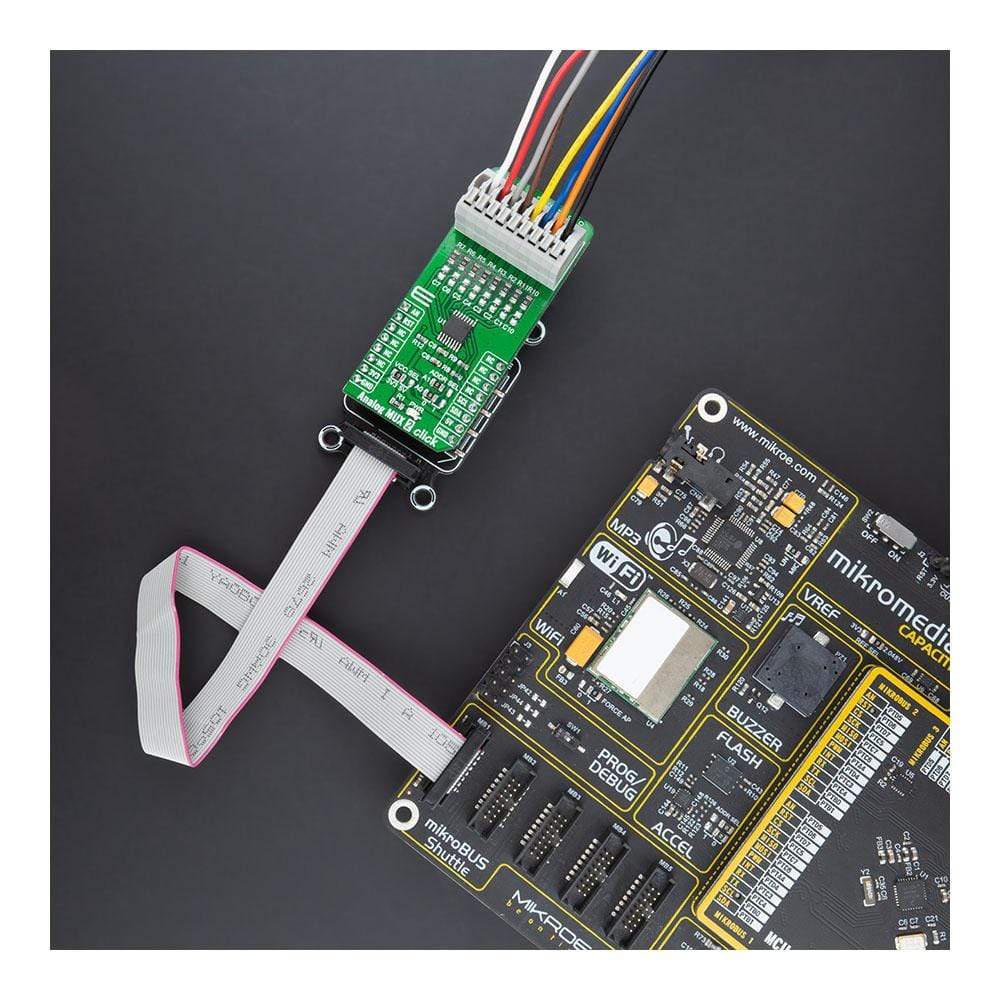
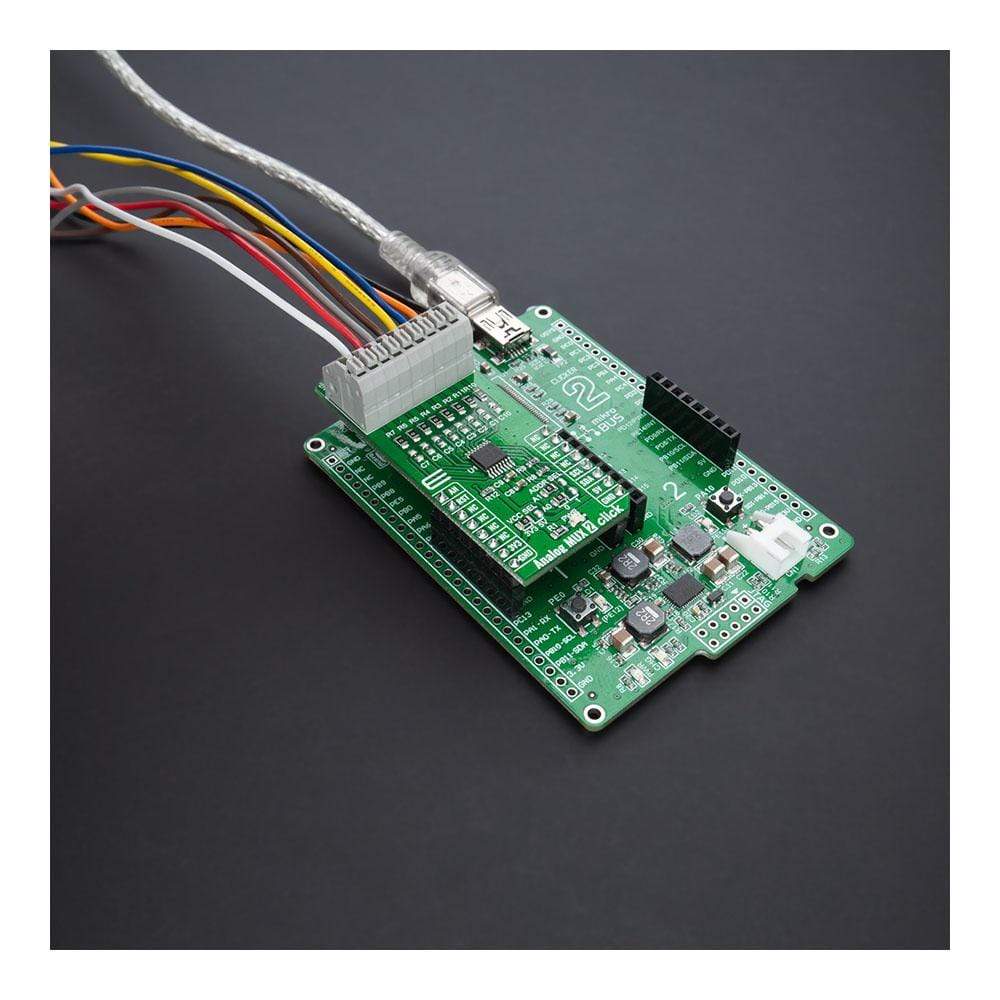
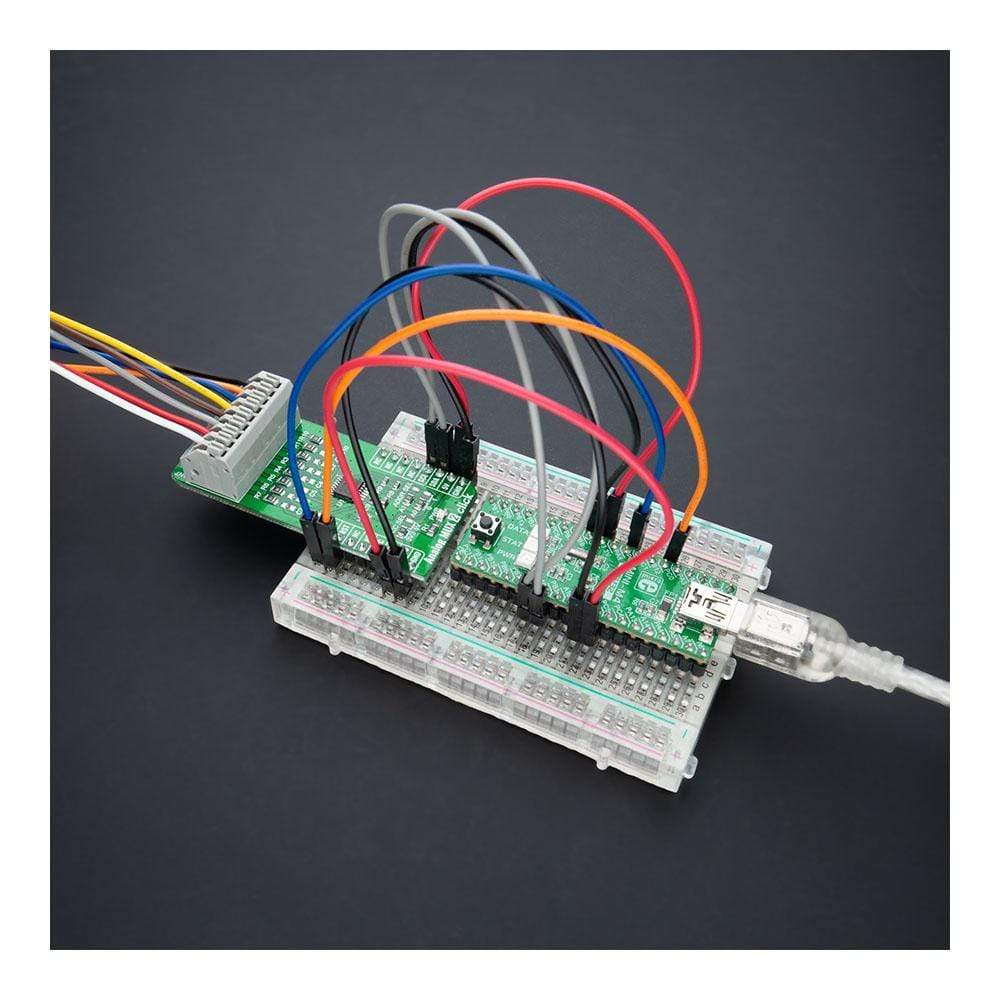
Key Features
Overview
The Analog MUX 2 Click Board™ is a compact add-on board that switches one of the eight inputs to one output. This board features the ADG728, a low voltage, CMOS 8-channel analogue matrix switch with a serially controlled 2-wire interface from Analog Devices. The ADG728 can operate equally well as either multiplexer, demultiplexer, or switch array easily connected to a nine-pole spring action block terminal. It provides flexibility and features a low on-resistance closely matched between switches and flat over the entire signal range. This Click Board™ is suitable for various applications, from industrial and instrumentation to medical, consumer, communications, and automotive systems.
The Analog MUX 2 Click Board™ is supported by a mikroSDK compliant library, which includes functions that simplify software development. This Click Board™ comes as a fully tested product, ready to be used on a system equipped with the mikroBUS™ socket.
Downloads
How Does The Analog MUX 2 Click Board™ Work?
The Analog MUX 2 Click Board™ is based on the ADG728, a low voltage, CMOS 8-channel analogue matrix switch with a serially controlled 2-wire interface from Analog Devices. The ADG728 can operate equally well as either multiplexer, demultiplexer, or switch array, providing more flexibility. It also features a low on-resistance closely matched between switches and very flat over the full signal range. During the Power-Up of the ADG728, all switching channels will be in the OFF condition, and the internal shift register will contain all zeros. All channels exhibit 'break-before-make' switching action preventing momentary shorting when switching channels.

Each bit of the 8-bit serial word corresponds to one switch of the device. Internal switching channels are independently controlled by an individual bit, providing an option of having any, all, or none of the switches activated. All of the input channels of the multiplexer can be easily connected to a 9 pole spring action block terminal, without having to use any additional tools, such as screwdrivers, while the output pin from the multiplexer is routed to the AN pin on the mikroBUS™ socket.
The Analog MUX 2 Click Board™ communicates with MCU using the standard I2C 2-Wire interface with a frequency of up to 400kHz. It also has two address pins (A0 and A1) programmed by the user to determine the value of the last two LSBs of the slave address, selected by onboard SMD jumpers labelled as ADDR SEL to an appropriate position marked as 0 and 1, allowing selection of the slave address LSBs. Also, this Click board™ has a Reset pin routed to the RST pin on the mikroBUS™ socket, which clears the input register and turns all switches to the OFF condition.
When changing the switch conditions, a new 8-bit word is written to the input shift register. The ADG728 compares the state of switches from the previous write cycle to minimize glitches on the switches output. This can be achieved if the switch is already in the ON condition and is required to stay ON.
The Analog MUX 2 Click Board™ is designed to operate with both 3.3V and 5V logic voltage levels selected via the VCC SEL jumper. It allows for both 3.3V and 5V capable MCUs to use the I2C communication lines properly. However, the Click board™ comes equipped with a library that contains functions and an example code that can be used, as a reference, for further development.
SPECIFICATIONS
| Type | Port expander |
| Applications | Can be used for a wide range of applications, from industrial and instrumentation to medical, consumer, communications, and automotive systems. |
| On-board modules | ADG728 - low voltage, CMOS 8-channel analogue matrix switch with a serially controlled 2-wire interface from Analog Devices |
| Key Features | 8-to-1 matrix switch, low on-resistance, 'Break-Before-Make' switching action, serially controlled, and more. |
| Interface | Analog, I2C |
| Compatibility | mikroBUS |
| Click board size | L (57.15 x 25.4 mm) |
| Input Voltage | 3.3V or 5V |
PINOUT DIAGRAM
This table shows how the pinout of the Analog MUX 2 Click Board™ corresponds to the pinout on the mikroBUS™ socket (the latter shown in the two middle columns).
| Notes | Pin |  |
Pin | Notes | |||
|---|---|---|---|---|---|---|---|
| Analog Signal | AN | 1 | AN | PWM | 16 | NC | |
| Reset | RST | 2 | RST | INT | 15 | NC | |
| NC | 3 | CS | RX | 14 | NC | ||
| NC | 4 | SCK | TX | 13 | NC | ||
| NC | 5 | MISO | SCL | 12 | SCL | I2C Clock | |
| NC | 6 | MOSI | SDA | 11 | SDA | I2C Data | |
| Power Supply | 3.3V | 7 | 3.3V | 5V | 10 | 5V | Power Supply |
| Ground | GND | 8 | GND | GND | 9 | GND | Ground |
ONBOARD SETTINGS AND INDICATORS
| Label | Name | Default | Description |
|---|---|---|---|
| LD1 | PWR | - | Power LED Indicator |
| JP1 | VCC SEL | Left | Logic Level Voltage Selection 3V3/5V: Left position 3V3, Right position 5V |
| JP2 | ADDR SEL | Left | I2C Address Selection 0/1: Left position 0, Right position 1 |
ANALOG MUX 2 CLICK ELECTRICAL SPECIFICATIONS
| Description | Min | Typ | Max | Unit |
|---|---|---|---|---|
| Supply Voltage | 3.3 | - | 5 | V |
| Analog Input Signal Range | 0 | - | 5 | V |
| On-Resistance | - | 6 | 12 | Ω |
| Operating Temperature Range | -40 | +25 | +85 | °C |
| General Information | |
|---|---|
Part Number (SKU) |
MIKROE-4468
|
Manufacturer |
|
| Physical and Mechanical | |
Weight |
0.022 kg
|
| Other | |
Country of Origin |
|
HS Code Customs Tariff code
|
|
EAN |
8606027381720
|
Warranty |
|
Frequently Asked Questions
Have a Question?
Be the first to ask a question about this.

